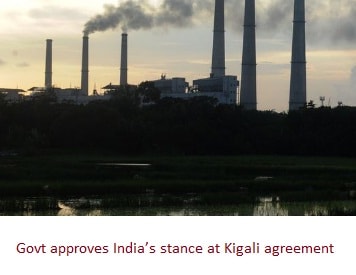
The government on Dec 2
nd gave its ex-post facto approval to the India's position at recent negotiations at Kigali, Rwanda over the issue of phasing down the climate-damaging refrigerants hydrofluorocarbons (HFCs).
The Kigali meet occurred during October 6-14 where India had successfully negotiated the baseline years and freeze year for phasing down the use of HFCs.
The country's position is aimed at allowing sufficient room for growth of its domestic sectors using refrigerants.
Freezing year is the year when use of HFCs will peak before being scaled down.
Baseline years are the years for which the average production\consumption quantity of HFCs is taken as the upper limit (serves as a level).
Two set of baselines years are there for developing countries.
India along with nine other countries will have
baseline years of
2024-26 while other developing countries including China (largest producer of HFCs in the world), Brazil and South Africa will have 2020-22 baseline.
The developed countries, led by the US, will on the other hand reduce use of HFCs over a 2011-13 baseline.
The
freezing year for India will be
2028, with a condition that there will be a technology review in 2024/2025 and, if the growth in the sectors using refrigerants is above certain agreed threshold, India can defer its freeze up to 2030.
The freezing year of China, Brazil, South Africa and others will be 2024.
The Kigali amendments to the Montreal Protocol will also, for the first time, incentivise improvement in energy efficiency in case of use of new refrigerant and technology.
Kigali Agreement- The negotiations at Kigali were aimed at including HFCs in the list of chemicals an phasing them out.
- This is under the Montreal Protocol.
- India will complete its phase down in four steps with cumulative reduction of:
a. 10% in 2032,
b. 20% in 2037,
c. 30% in 2042 and
d. 85% in 2047.- Developed countries US, Japan and west EU will lower production and consumption of HFCs by 70% in 2029 and 85% by 2036.